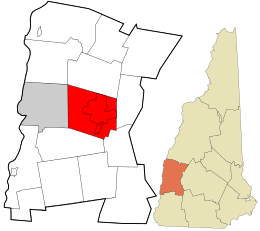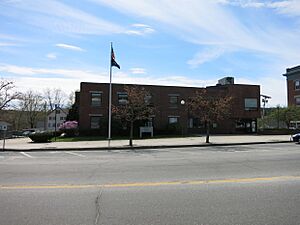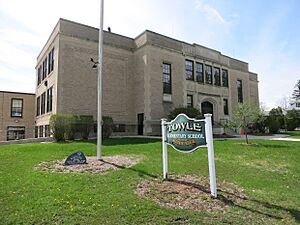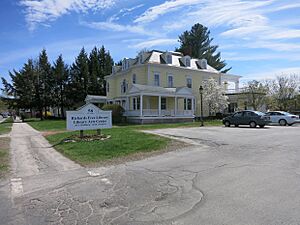Newport, New Hampshire facts for kids
Quick facts for kids
Newport, New Hampshire
|
|
|---|---|

Center of Newport in 2016
|
|
| Nickname(s):
"The Sunshine Town"
|
|

Location in Sullivan County and the state of New Hampshire
|
|
| Country | United States |
| State | New Hampshire |
| County | Sullivan |
| Incorporated | 1761 |
| Villages | |
| Area | |
| • Total | 43.64 sq mi (113.04 km2) |
| • Land | 43.57 sq mi (112.85 km2) |
| • Water | 0.07 sq mi (0.19 km2) 0.16% |
| Elevation | 814 ft (248 m) |
| Population
(2020)
|
|
| • Total | 6,299 |
| • Density | 145/sq mi (55.8/km2) |
| Time zone | UTC-5 (Eastern) |
| • Summer (DST) | UTC-4 (Eastern) |
| ZIP codes |
03773 (Newport)
03754 (Guild) |
| Area code(s) | 603 |
| FIPS code | 33-52580 |
| GNIS feature ID | 0873684 |
Newport is a town in New Hampshire, United States. It is the main town of Sullivan County. Newport is about 43 miles (69 km) northwest of Concord, the state capital.
In 2020, about 6,299 people lived in Newport. You can find a covered bridge in the northwest part of town. The area is also known for its maple sugar and apple farms. Newport was part of Cheshire County until 1827. The main part of town, where most people live, is next to the Sugar River. It is located where New Hampshire routes 10 and 11 meet. Other small villages in Newport include Kelleyville, Guild, and North Newport.
Contents
History of Newport
How Newport Got Its Name
Newport was first given land in 1753 by Governor Benning Wentworth. It was first called "Grenville" after George Grenville, who was the Prime Minister of Great Britain. But there were wars happening, like the French and Indian War, which made it hard for people to settle there.
In 1761, the town was officially named "Newport". This name honored Henry Newport, a famous English soldier and leader.
Early Settlers and Challenges
The first settlers arrived in 1763 from North Killingworth, Connecticut. Absalom Kelsey was one of the very first people to settle in the area. At first, the Connecticut River was the only way to travel. Later, a road was built through the wild lands to Charlestown in 1767. The first gristmill, which grinds grain, was built the next year.
In 1781, Newport and 33 other towns along the Connecticut River decided to leave New Hampshire and join Vermont. They were not happy with how the state government treated them. However, George Washington stepped in and ended their union with Vermont in 1782. So, the towns rejoined New Hampshire.
Growth and Industry
Newport had great soil for farming. It also had lots of water power from the Sugar River and its South Branch. This power was perfect for running mills. The town quickly became successful.
The first cotton mill was started by Colonel James D. Wolcott in 1813. Local cabinet making also grew, and many beautiful pieces of furniture were made. In 1817, some business people thought about building a canal. This canal would connect the Connecticut and Merrimack rivers. They planned to use the Sugar River and Lake Sunapee as a water source. But this plan was never started.
In 1871, the Sugar River Railroad connected Newport to Bradford. This helped the town grow even more.
The Sugar River's Importance
The Sugar River was very important for Newport's industries. In 1820, mill owners from Newport and nearby towns worked together. They created the Sunapee Dam Corporation. This group built a dam to control the river's flow. This meant mills could keep working even when there wasn't much rain.
This plan worked well! More than 120 water wheels used the river's power. By 1859, Newport had a population of 2,020 people. It had three woolen mills and two tanneries (places where leather is made). The Sibley Scythe Company, started in 1842, made scythes. These tools were even used to clear jungles when the Panama Canal was being built! The company closed in 1929.
Newport has many important old buildings. These include the South Congregational Church, built in 1823. The Newport Opera House was built in 1886. The Richards Free Library, built in 1898, was once the home of Colonel Seth Mason Richards.
Newport's First Families (1766)
In the summer and fall of 1765, six young men came to Newport from Killingworth, Connecticut. They cleared six acres of land each and planted rye. Then, they went home for the winter.
The next year, in June 1766, eight men came back. Five of them brought their families. They made the first lasting settlement in Newport. People say they arrived on a Saturday night. They had to camp on Pike Hill because of a bad spot in the road. The next day, they finished their journey and spent the day in religious worship. They gathered under a large pine tree.
Here are some of the earliest settlers. The first five listed brought their families:
- Zepheniah Clark
- Ebenezer Merrit
- Benjamin Bragg
- Samuel Hurd
- Jesse Wilcox
- James Church
- William Stanard
- Ezra Parmelee
- Jesse Lane
- Jesse Kelsey
- Benjamin Giles
- Nathan Hurd
- Charles Avery
- Ephraim Towner
- Absalom Kelsey
- Amos Hall
- Roswell Hull
- Daniel Dudley
Geography and Location
Newport covers about 43.6 square miles (113.0 square kilometers) of land. Only a tiny part, about 0.16%, is water. Besides downtown Newport, other small areas in town include North Newport, Kelleyville, Guild, and Wendell.
The Sugar River flows through Newport, heading west. The center of town is where the Sugar River and its South Branch meet. The North Branch also joins the Sugar River north of Newport village. All the water in Newport eventually flows into the Connecticut River. The highest point in town is a ridge on its southern border, which is about 1,920 feet (585 meters) above sea level.
Newport is served by state routes 10, 11, and 103. The town also has its own airport, called Parlin Field Airport.
Nearby Towns
Newport is next to these towns:
- Croydon (to the north)
- Sunapee (to the east)
- Goshen (to the southeast)
- Unity (to the south)
- Claremont (to the west)
Newport's Climate
Newport has a climate with warm summers and cold, snowy winters. The hottest temperature ever recorded in Newport was 97°F (36°C) on July 15, 1995. The coldest temperature ever recorded was -40°F (-40°C) on January 20, 1994.
Population and People
| Historical population | |||
|---|---|---|---|
| Census | Pop. | %± | |
| 1790 | 780 | — | |
| 1800 | 1,266 | 62.3% | |
| 1810 | 1,427 | 12.7% | |
| 1820 | 1,679 | 17.7% | |
| 1830 | 1,913 | 13.9% | |
| 1840 | 1,958 | 2.4% | |
| 1850 | 2,020 | 3.2% | |
| 1860 | 2,077 | 2.8% | |
| 1870 | 2,163 | 4.1% | |
| 1880 | 2,612 | 20.8% | |
| 1890 | 2,623 | 0.4% | |
| 1900 | 3,126 | 19.2% | |
| 1910 | 3,765 | 20.4% | |
| 1920 | 4,109 | 9.1% | |
| 1930 | 4,659 | 13.4% | |
| 1940 | 5,304 | 13.8% | |
| 1950 | 5,131 | −3.3% | |
| 1960 | 5,458 | 6.4% | |
| 1970 | 5,899 | 8.1% | |
| 1980 | 6,229 | 5.6% | |
| 1990 | 6,110 | −1.9% | |
| 2000 | 6,269 | 2.6% | |
| 2010 | 6,507 | 3.8% | |
| 2020 | 6,299 | −3.2% | |
| U.S. Decennial Census | |||
In 2010, there were 6,507 people living in Newport. Most people living in Newport are white. About 22.8% of the population was under 18 years old. The average age of people in Newport was about 41.7 years.
Important Buildings and Services
Education in Newport
Newport has public schools run by the Newport School District. Richards Elementary School teaches children from kindergarten to 5th grade. Newport Middle and High Schools teach students from 6th to 12th grades.
In 2016, 5th and 6th graders from Towle Elementary moved to other schools. The Towle building is still used for sports. There is also a private school in Newport called the Newport Montessori School. It teaches students from pre-kindergarten up to 8th grade.
Famous People from Newport
Many interesting people have come from Newport:
- Henry Albert Baker (1848–1934), an early expert in orthodontics (straightening teeth).
- George Belknap (1832–1903), a rear admiral in the U.S. Navy.
- Edmund Burke (1809–1882), who served in the U.S. Congress.
- Harry Morrison Cheney (1860–1937), who was the Speaker of the New Hampshire House of Representatives.
- Austin Corbin (1827–1896), a business leader in banking and railroads.
- Horatio Hale (1817–1896), a businessman and a person who studied different cultures (ethnologist).
- Sarah Josepha Hale (1788–1879), a famous editor and writer.
- Evan Hill (1919–2010), a journalist and professor at the University of Connecticut.
- Henry Harrison Metcalf (1841–1932), an editor, politician, and author.
- David Sargent (born 1931), who was the president of Suffolk University.
- Edwin Obed Stanard (1832–1914), who served in the U.S. Congress.
- Mason Weare Tappan (1817–1886), a U.S. congressman and state attorney general.
- Billy B. Van (1870–1950), a popular vaudeville entertainer.
Images for kids
-
South Congregational Church around 1910
-
Corbin Covered Bridge over North Branch Sugar River
-
Sarah J. Hale plaque
See also
 In Spanish: Newport (Nuevo Hampshire) para niños
In Spanish: Newport (Nuevo Hampshire) para niños






















